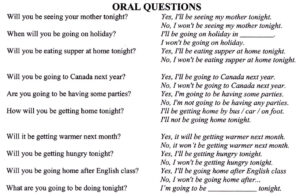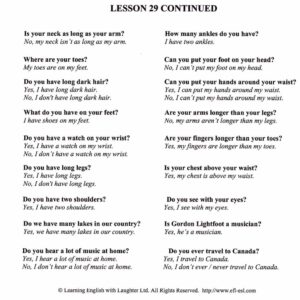Tips on Choosing an ESL Curriculum
- Posted by Daisy Stocker
- Date August 27, 2014
- Comments 1 comment
What is the basic goal of any ESL program?
“Why, that’s easy”, you might say, “it is to teach English students to speak ” If that’s the case, why do so many programs fail? In Canada, most students took French in school, but very few people can speak even passable French. In the Czech Republic, all of our students studied Russian, but they told us that after seven years of instruction, none of them could speak Russian.
Wherever we taught, we had a list of ten to twenty oral questions for each lesson.
Each question is a complete sentence, and we always asked that the student give a complete sentence for an answer. If the lesson was about the past tense, all of the oral questions were in the past tense. In every lesson, each student was asked at least one question, and they were asked in random order, so that they all stayed alert and ready to answer. In our teaching, we always used evaluation quizzes. Every few weeks we gave each student a short form to fill out. The form listed all of the things that we did in our lessons. They were asked to evaluate each of them, with a 10 for most helpful and a 1 for least helpful. We used these forms on well over 1000 students, and neither of us ever got a value of less than 7 for oral questions. Mostly they responded with an 8, 9 or 10. So we found that not only were oral questions very popular with the students, but it got them speaking in sentences, and learning proper word order.
See also – choosing children’s curriculum
Learning vocabulary words is not enough!
We spent a month in Spain as students in a language school. They told us to make flash cards of the vocabulary words. After a month, we both had about 600 to 700 cards, and we could parrot back the correct words pretty consistently. However, when we went into town, we were completely tongue tied when we went into a restaurant. After the waiter had left, we could carefully put together what we should have said.
Motivation.
Teachers all over the world know that the drop out rate of ESL students can be quite alarming. In the first cold winter we spent teaching in Eastern Europe, we found that the students were likely to get sleepy after the first half hour. We found that many got up at 5 or 6 in the morning, worked all day, and then came to class at 4 PM. Sitting comfortably in the warm room made them sleepy. We decided that it was our job the design activities that taught English, and were lively and fun enough to combat this sleepiness.
An ESL curriculum should have lots of activities that keep students on their toes. Remember, we all like to win; we have seen lots of surgeons, lawyers, and politicians grin all over when they get a stamp on their books for winning a simple Bingo game!
Overcoming fear.
From childhood, most people have been taught that they shouldn’t make mistakes. It is the job of the teacher to show the students that mistakes are OK; they are an essential part of the learning process. A curriculum should utilize the mastery approach. Students should master each segment of their learning, before they are given a lot more information to deal with. A curriculum that has a test after every few lessons accomplishes this.
I remember a class of beginners that had a test after only four lessons. All of the class got marks in the high eighties and nineties. One girl got 98% and her friend got 99%! By using the mastery approach, students can get marks like these, which overcome fear, and build confidence.
Student Involvement.
An ESL curriculum should include small group activities in which the students work together. In this way, they help each other, and overcome any reluctance to speak and teach English to each other.
Affordability.
Every school has to consider affordability. So while all of the above are major considerations, the students are going to have to be able to afford to pay for the books.
For Textbook Curriculum
- Assess the Learner’s Level
- Ensure the curriculum matches the level of your students, beginners, intermediate, or advanced learners. Check if the curriculum offers an assessment.
- Consider the Learner’s Age
- Choose materials appropriate for the age group, as content and delivery methods can differ significantly for children, teenagers, and adults.
- Comprehensive Coverage:
- An ESL textbook should cover all language skills, including, reading, writing, listening, and speaking.
- Review Content and Themes:
- Ensure the themes and topics are engaging, relevant, and culturally sensitive to the learners.
- Are there Supplementary Materials?
- Check if the textbook comes with additional resources like workbooks, audio, video, online practice, or teacher’s guides.
- Look for Reviews and Recommendations and other Teacher’s Experience
- Read reviews from other educators and see which textbooks are widely recommended within the ESL teaching community.
ESL Curriculum and Lesson Plans PDF Download or Paperback
Tips for Choosing Online Curriculum
- Interactivity
- The curriculum includes interactive elements like quizzes, games, and activities to engage learners.
- Multimedia
- Look for multimedia (videos, audio, animations) to cater to different learning styles.
- User-Friendly Interface
- The platform should be easy to navigate for both teachers and students.
- Progress Tracking
- Choose programs that allow tracking of student progress and provide feedback.
- Teacher Support and Teacher Guide
- Look for ESL programs that offer teacher support, training, and resources to facilitate effective instruction.
- Trial Periods
- Use the trial period to evaluate the curriculum before making a commitment.
- Cost and Value:
- Consider the cost in relation to the value and comprehensiveness of the curriculum. Ensure it fits within your budget while meeting educational needs.
Teaching Online – Everything you Need to Know Online Courses
Choosing and Using an Adult Curriculum
- Spending Less on Curriculum - Many of the countries of the world are facing difficult economic times. Radical changes are taking place each day as people struggle to earn enough to maintain their standard of …
- Using Your ESL Curriculum - ESL Adult Curriculum are available by the thousands. If you have already chosen a curriculum, in all probability it is satisfactory, but how the teacher uses it is the big question. …
- Getting English Second Language Beginners Started with Our Curriculum - When beginning students enroll in an ESL class, they are likely to come in with quite a bit of anxiety. They want to learn English, but many of them will …
- Tips on Choosing an ESL Curriculum - “Why, that’s easy”, you might say, “it is to teach English students to speak ” If that’s the case, why do so many programs fail? In Canada, most students took …
Date Published: 2014-08-27
Date Modified: 2024-05-21
Daisy Stocker taught ESL in Eastern Europe for 10 years and was a primary school teacher in Canada for 30 years. Daisy has a B.A. and M Ed. in Education.
You may also like

Spending Less on Curriculum
Using Your ESL Curriculum
ESL Adult Curriculum are available by the thousands. If you have already chosen a curriculum, in all probability it is satisfactory, but how the teacher uses it is the big question. …
Getting English Second Language Beginners Started with Our Curriculum
When beginning students enroll in an ESL class, they are likely to come in with quite a bit of anxiety. They want to learn English, but many of them will …



1 Comment